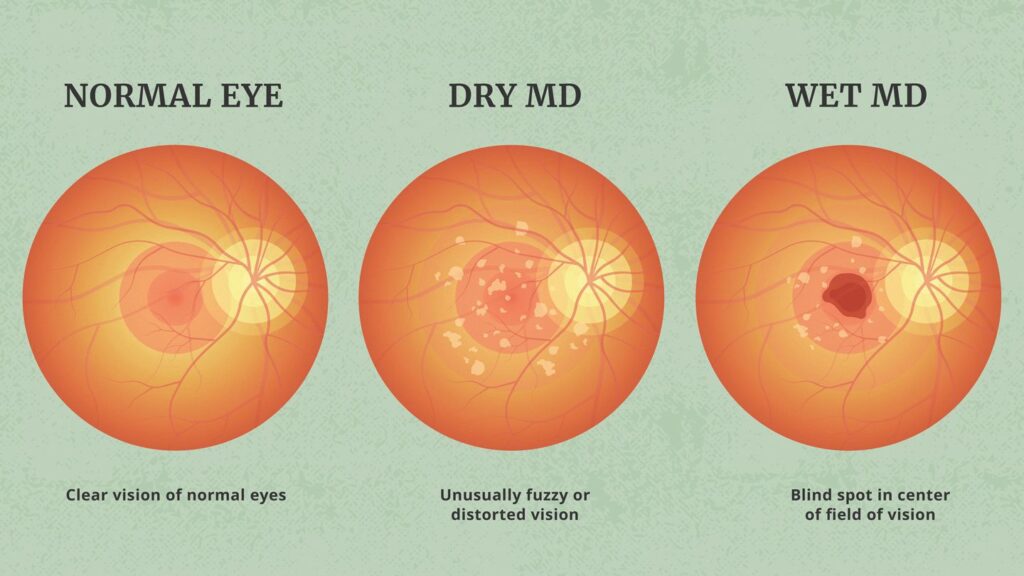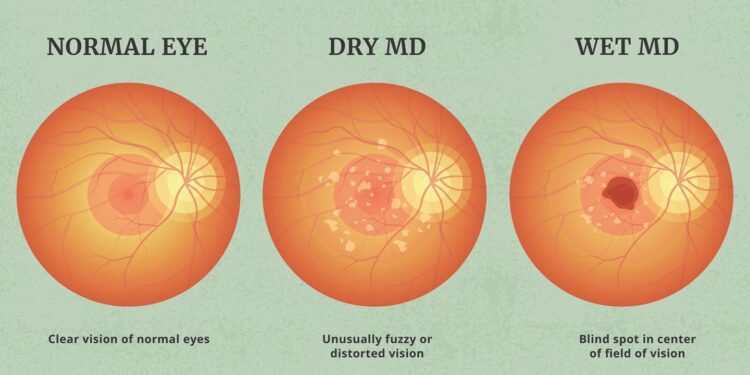Among participants with intermediate-stage age-related macular degeneration (AMD), supplementation with lutein plus zeaxanthin reduced the risk of progression to late-stage AMD. Conversely, supplementation with either beta-carotene, high-dose zinc, or omega-3s had no effect on AMD and, additionally, beta-carotene increased the risk of lung cancer.

BACKGROUND
Age-related macular degeneration (AMD) is an eye disease that causes impaired visual function. The underlying cause of AMD is damage to the macula, the area of the retina with the highest concentration of photoreceptor cells. AMD is a progressive disease and can be classified as early, intermediate, or late depending on its severity. Pathological changes begin in early AMD, but eyesight is usually unaffected. In intermediate AMD, retinal damage progresses and some blurring of vision is common, but eyesight is relatively unchanged, such that most people overlook much degeneration. Finally, late AMD is characterized by damage building to the point where central blindness and other visual problems occur.
Certain compounds in food may be able to help prevent or alleviate AMD. These include lutein and zeaxanthin, omega-3 fatty acids, zinc, and beta-carotene.
Lutein and zeaxanthin: These structurally related pigment molecules are present in several foods, especially green vegetables like kale, spinach, and Swiss chard. These compounds seem to preferentially accumulate in the macula and retina, where they’re hypothesized to exert antioxidant effects directly (by scavenging free radicals) and indirectly (by absorbing blue light). Additionally, some observational studies have reported associations between higher lutein and zeaxanthin intakes and a lower risk of late AMD.
Omega-3s: The long chain omega-3 fatty acids found predominantly in seafood potentially play a positive role in eye health, in part because the photoreceptor cells of the retina seem to be uniquely rich in omega-3 fatty acids. Observational studies have also reported higher omega-3 intakes are linked to a lower risk of AMD. However, clinical trial evidence is somewhat lacking.
Zinc: A higher dietary intake of this essential mineral has been linked to a lower risk of AMD in some cohort studies, but not others. Meanwhile, one clinical trial reported that zinc supplementation, at a dose higher than typically obtained from the diet (80 mg), seemed to prevent late AMD.
Beta-carotene: This vitamin A precursor, often found in orange-coloured (e.g., carrots, pumpkin, and sweet potatoes) and green-coloured (e.g., kale and collard greens) foods, has been suggested to be beneficial in the context of AMD-based on its antioxidant properties. Large clinical trials have mostly either not observed any clear effect or did not see benefits, but also combined beta-carotene with other nutrients like vitamin C and E, making it difficult to tell whether beta-carotene was responsible for the effect.
Given the unclear but promising role of these compounds for AMD, this study was designed to examine whether these supplements could prevent people with intermediate AMD from progressing to late AMD.
The study
This follow-up to a 5-year randomized controlled trial known as the Age-Related Eye Disease Study 2 (AREDS2) examined whether various supplements could prevent the progression of intermediate AMD to late AMD. Older adults (average age of 72) with intermediate AMD were assigned to several intervention combinations using a primary and secondary randomization process. Of participants completing the first follow-up, a total of 3,882 people were included in the primary randomization and 2,795 participants were included in the secondary randomization.
In the primary randomization, the participants were assigned to take one of the following:
- Lutein (10 mg) and zeaxanthin (2 mg)
- The omega-3 fatty acids eicosapentaenoic acid (EPA, 650 mg) and docosahexaenoic acid (DHA, 350 mg)
- Lutein plus zeaxanthin and EPA plus DHA
- A placebo
In the secondary randomization, the participants were additionally assigned to take one of the following:
- 80 mg of zinc and 15 mg of beta-carotene
- 25 mg of zinc and 15 mg of beta-carotene
- 80 mg of zinc and no beta-carotene
- 25 mg of zinc and no beta-carotene
As a result, 16 possible groups were created.
Since beta-carotene had previously been shown to increase the risk of lung cancer among smokers, participants who smoked or had quit smoking within the previous year were assigned only to groups not receiving beta-carotene. Additionally, all participants received 500 mg of vitamin C, 2 mg of copper, and 400 IU of vitamin E.
After the completion of the initial 5-year trial, the participants were followed up with for an additional 5 years via telephone correspondence every 6 months to further assess study outcomes. The primary outcomes were progression to late AMD and the incidence of lung cancer.
References
1. ^Ma L, Dou HL, Wu YQ, Huang YM, Huang YB, Xu XR, Zou ZY, Lin XMLutein and zeaxanthin intake and the risk of age-related macular degeneration: a systematic review and meta-analysis.Br J Nutr.(2012-Feb)
2. ^Kishan AU, Modjtahedi BS, Martins EN, Modjtahedi SP, Morse LSLipids and age-related macular degeneration.Surv Ophthalmol.(2011)
3. ^Mares-Perlman JA, Klein R, Klein BE, Greger JL, Brady WE, Palta M, Ritter LLAssociation of zinc and antioxidant nutrients with age-related maculopathy.Arch Ophthalmol.(1996-Aug)
4. ^van Leeuwen R, Boekhoorn S, Vingerling JR, Witteman JC, Klaver CC, Hofman A, de Jong PTDietary intake of antioxidants and risk of age-related macular degeneration.JAMA.(2005-Dec-28)
5. ^Cho E, Stampfer MJ, Seddon JM, Hung S, Spiegelman D, Rimm EB, Willett WC, Hankinson SEProspective study of zinc intake and the risk of age-related macular degeneration.Ann Epidemiol.(2001-Jul)


